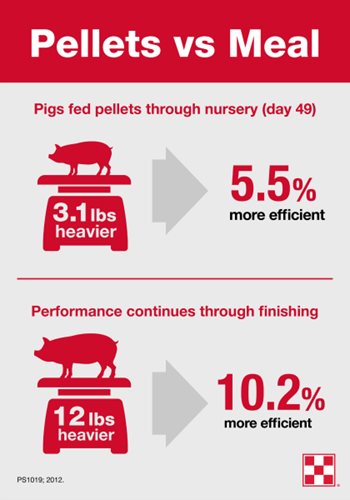
The Value of Pelleted Pig Nursery Diets
Young Animal : Nutrition

Pelleting pig feeds can support improvements in management and pig performance.
When should you consider a pelleted diet versus a meal diet for your pigs? Always weigh the cost of pelleting feeds to the potential economic benefits the pelleted diet could bring to your bottom line. If you do the math, you’ll often find the potential benefits of pelleted feed outweigh the costs.
Here are some benefits to pelleted pig nursery diets:
Results from the nursery period continued into the grow-finish period. Pigs that continued on pelleted diets post-nursery were on average 12 pounds heavier and 10.2 percent more efficient at finishing than those on meal diets.2
1Hancock, J.D. and Behnke, K.C. 2001. Use of ingredients and diet processing techniques (grinding, mixing, pelleting and extrusion) to produce quality feed for pigs. Chapter 21. In: Swine Nutrition, A.J. Lewis and L.L. Southern, Eds., CRC Press LLC, Boca Raton, FL. Pp. 469-497.
2PS1019; 2012
When should you consider a pelleted diet versus a meal diet for your pigs? Always weigh the cost of pelleting feeds to the potential economic benefits the pelleted diet could bring to your bottom line. If you do the math, you’ll often find the potential benefits of pelleted feed outweigh the costs.
Here are some benefits to pelleted pig nursery diets:

- Pelleting a diet helps make it easier to handle feed and helps reduce feed waste.
- Pelleting feed supports optimal performance: Research has shown pelleted feed supports a 7 percent improvement in feed efficiency.1 This improvement can result in as much as 7 pounds less of feed needed to produce 100 pounds of pig weight, or, said another way, a savings of 7 pounds of feed per each 100 pounds of weight gain.
- Pelleting allows the pig feed manufacturer to reduce the particle size of the grain without creating the bridging and handling problems that can be typical of finely ground meal feed.
- Pelleting supports nutrient digestibility because the heat of the pelleting process breaks down carbohydrate bonds, making them more digestible for pigs.
Benefits of pelleted pig feeds: Proof by the pound
Research at the Purina Animal Nutrition Center, the company’s working farm in Gray Summit, Missouri, supports the benefits of pelleted feed for swine. In the nursery, pigs fed pelleted diets were 3.1 pounds heavier at Day 49 and had 5.5 percent improved feed efficiency when compared to pigs fed meal diets.2Results from the nursery period continued into the grow-finish period. Pigs that continued on pelleted diets post-nursery were on average 12 pounds heavier and 10.2 percent more efficient at finishing than those on meal diets.2
Recommendation
Seek out a source for good quality pellets. Do your own economic analysis on the cost benefits of pelleting nursery diets. More often than not, it pays to pellet your diets at least through the nursery phase of your feeding program.1Hancock, J.D. and Behnke, K.C. 2001. Use of ingredients and diet processing techniques (grinding, mixing, pelleting and extrusion) to produce quality feed for pigs. Chapter 21. In: Swine Nutrition, A.J. Lewis and L.L. Southern, Eds., CRC Press LLC, Boca Raton, FL. Pp. 469-497.
2PS1019; 2012


